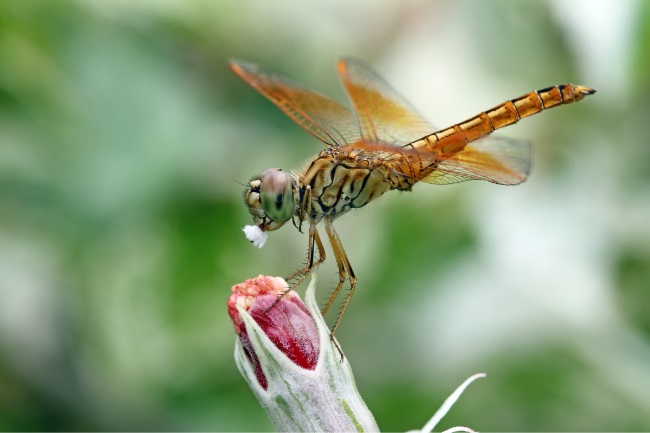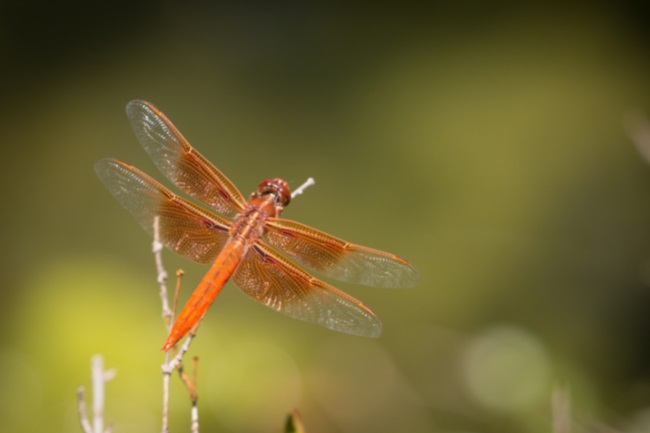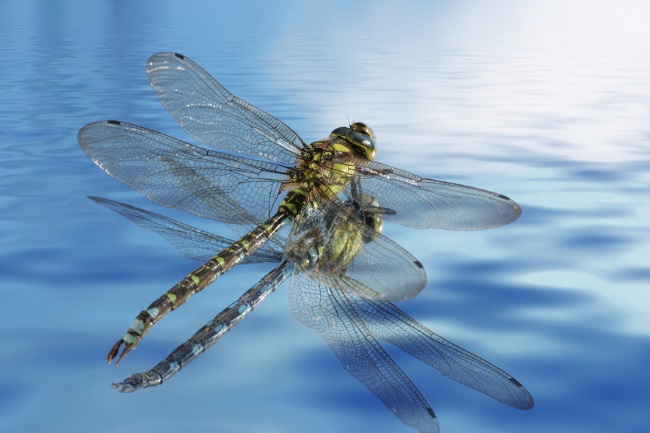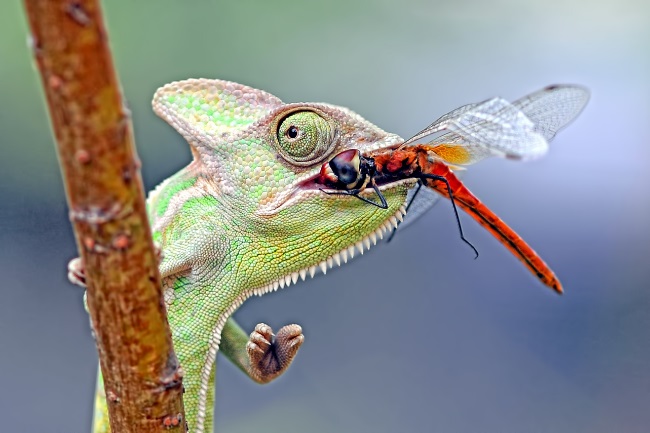Dragonflies need to eat large numbers of small invertebrates in order to transition through their various life stages and successfully mate. Because of their hunting skill, few insects can escape their grasp once they have laid eyes on them. They will eat most types of small invertebrates, however, flies, mosquitoes, and moths are some of their favourites.
Contents
What are a dragonfly’s eating habits?

Dragonflies are voracious eaters, needing to consume large amounts of food in order to grow quickly and become adults. As larva, they live within the water, or the sediment at the bottom, and use their face masks to grab passing aquatic invertebrates. The mask is part of their jaw but looks in many ways like an extendable claw.
Many larvae use different methods for getting their prey, such as hiding amongst vegetation or submerging themselves in silt. They are ambush predators, yet they also need to be wary of all the things that want to eat them.
| Life Stage | Diet |
|---|---|
| Larvae (Nymphs) | Small aquatic organisms, including mosquito larvae, small fish, tadpoles, and other invertebrates found in freshwater habitats. |
| Adults | Flying insects such as mosquitoes, flies, bees, butterflies, moths, beetles, and other small flying insects. They are opportunistic predators. |
They will eat a range of aquatic invertebrates, from mosquito larvae to other dragonfly young. Larger larvae will even eat small fish and amphibians.
Once they are adults, the dragonflies will emerge from the water and become proficient aerial predators. With their new wings, they will grab up anything they can as they swoop through the air, from mosquitos to moths. They primarily catch their prey with their legs, grasping hold of them as they fly past.
Also read: Is a Dragonfly a Vertebrate or an Invertebrate?
How do dragonflies eat?
Dragonflies eat their food using their jaws, munching up their often still living prey and swallowing them down. This isn’t too dissimilar to how we eat, aside from the still living part. However, a dragonflies jaw is a little different from that of a mammal, having several different components, including the mandibles, which are used to grasp and tear up the food, and the maxillae that help to chew it.
How often do they eat?
Dragonflies eat almost constantly, needing to fatten themselves up as quickly as possible so they can breed and produce young. Like all insects they require external heat to give them warmth and allow them to move, meaning they are largely inactive during cold weather or at nighttime. But both as larvae and as adult dragonflies, they will eat whenever they have the opportunity.
How do dragonflies catch their prey?

The way dragonflies move may seem completely random to us, but these extraordinary insects actually hunt with purpose and use cunning to catch their prey. Interestingly different species of dragonflies often use different styles of hunting to get their meals.
| Prey | Description |
|---|---|
| Mosquitoes | Dragonflies are known for their effective control of mosquito populations, as they actively feed on mosquito adults and larvae. |
| Flies | Various fly species, including midges, gnats, and houseflies, are common prey for dragonflies due to their abundance and accessibility. |
| Bees and Wasps | Dragonflies may catch and consume bees and wasps when they are in flight or foraging on flowers. |
| Butterflies and Moths | Flying insects like butterflies and moths, especially the smaller ones, are also part of the dragonfly’s diet. |
| Beetles and Other Insects | Dragonflies can capture and consume beetles, ants, damselflies, and other small flying or crawling insects. |
Gleaning
Gleaning is a method that involves hovering over leaves and vegetation in order to snatch up the tasty insects perching there. Dragonflies are extraordinary fliers and are able to hover or even fly backwards when required. Gleaning is commonly used by clubtails and damselfly species, who are a close relative of dragonflies.
Hawking
Hawking is a very common technique, where dragonflies fly backwards and forwards to capture prey as they pass by, either with their arms or their mouths. Extraordinarily agile fliers, it’s pretty hard for prey to escape a hawking dragonfly once it has them in its sights. It’s even been found dragonflies can plan their attacks, anticipating where their prey will head to next and intercepting them. Species like southern hawkers commonly use this technique.
Sallying
Sallying is a method used by species such as skimmers; this is where a dragonfly perches and looks for prey before darting out to grab it. You’ll notice dragonflies who use this technique perching on a twig or leaf and then darting swiftly out before perching again.
Dragonfly larvae

When we think of dragonflies, we tend to think of their adult form, which for us is the more visible and dramatic incarnation of a dragonfly. However, most dragonflies spend far more time as larvae than as adults. During their larval stage, they live under the water and eat aquatic invertebrates, such as mosquito larvae. Their technique here isn’t as varied as that of the adults, though they will often be specialised to a particular habitat within the water, such as the silty bottom or the weedy deeps.
Also read: How Long Does a Dragonfly Live for? (Lifecycle Explained)
What types of invertebrates do dragonflies eat?

Dragonflies really aren’t fussy eaters, the principal determiner as to whether they will give something a go being their size compared to its. Most invertebrates can fall prey to a hungry dragonfly, though flying insects are more likely to be predated. Flies are one of a dragonflies favourite foods, being readily available and easy to catch.
Do dragonflies eat mosquitos?
Mosquitos are ideal food for dragonflies, and they will eat them both when they are in their larval form and as adults. The larvae are the perfect food for the young dragonflies living their early days in the water, while a grown dragonfly can snap mosquitoes out of the air while it’s on the wing.
How many mosquitoes do dragonflies eat in a day?
It’s estimated a dragonfly can eat up to 100 mosquitoes a day.
Do dragonflies eat bees?
There are many different kinds of bees, and dragonflies will happily munch on any of them, from solitary bees to honey bees. Extra care must, of course, be taken with those that have stings, as they can use these to defend themselves. But with a dragonflies speed and size, most bees stand little chance as they are grabbed out of the sky and devoured by strong and merciless jaws.
Do dragonflies eat butterflies?
Dragonflies will certainly eat butterflies when they get the chance, though they aren’t their favourite food. Much of a butterfly is made up of large wings, which do not make a tasty snack. The time spent discarding these cumbersome extras could be taken up catching quick and easy flies to chomp down on.
Do dragonflies eat flies?
Flies are a dragonflies favourite food. Though we tend to think of flies as being house flies or blue bottles, there are actually 120,000 species globally, which come in all sorts of different shapes and sizes. This means the dragonfly has plenty of fodder available to fill their stomachs.
Do dragonflies eat spiders?
Who eats who is perhaps the question when it comes to dragonflies and spiders. The truth is that sometimes the spider gets the dragonfly, and sometimes the dragonfly gets the spider. The two groups can encounter each other in all kinds of situations. For example, aquatic spiders may meet dragonfly larvae underwater, while young spiders ballooning (floating through the air on a strand of silk) may encounter dragonflies as they swoop through the air. And of course, a dragonfly may meet a spider as it hangs out on its web.
With these various potential meetings, who is the prey and who is the predator will depend mainly on size and confidence. The larger adversary is likely to be the winner, with a dragonfly larva potentially gobbling up a diving spider or an adult dragonfly becoming trapped in a spider’s web.
Do dragonflies eat ants?
Dragonflies will eat ants, particularly if they encounter flying ants or an ant colony. However, as they spend much of their time on the wing, they are less likely to pick up solitary ants from the floor, though they certainly will if there are no other tasty snacks around.
Do dragonflies eat poisonous insects?
Insects have all kinds of ways to communicate with each other. One common form of communication is the colours that insects wear. Bright colours such as yellow or red usually indicate the insect is poisonous to eat, and should be avoided. Dragonflies, therefore, are likely to avoid those insects that are poisonous. Moving as quickly as they do, they may occasionally pick up poisonous insects by mistake; however, these are likely to be quickly discarded.
Do dragonflies eat hummingbirds?
The food web isn’t always as straight forward as we’d like to think. In a fight between a bird and an insect we’d be likely always to place our money on the bird to win, yet nature does like to surprise us from time to time.
Tales of dragonflies taking down and eating hummingbirds were largely dismissed for a long time, however, the reports kept coming. More recently photographic evidence has been put forward, showing a dragonfly in the act of pinning down it’s hummingbird prey.
While this may prove that dragonflies do on occasion attack hummingbirds it’s worth remembering that this is very rare and unusual behaviour. For the majority of dragonflies it wouldn’t even be an option, as they would be too small to achieve the desired outcome.
Even for larger species it’s a risky and tricky business. It’s thought that green darners and dragonhunters are the most likely species to take on this formidable task.
Do dragonflies eat ladybugs?
Dragonflies do eat ladybirds, even despite their unpleasant toxins. They will largely catch them on the wing, and eat them in the air. Wing casings will often be discarded as they have little nutritional value. With their superior maneuverability dragonflies can literally fly rings around the slow and somewhat clumsy ladybird.
Luckily for the ladybird, however, it’s only the adult dragonflies that have the chance to chow down on these brightly coloured insects. As the dragonfly larvae live in the water, and the ladybird larvae live on the land (or more specifically on plant stems and leaves) the two do not get a chance to meet.
Do dragonflies eat grass?
Dragonflies are carnivores, meaning that they only eat meat. They largely feed on small insect species, such as mosquitos and flies. They do not eat plant matter such as grass, however because they spend a great deal of time perching in grasses and rushes at the side of pools and streams, it’s easy to mistake them for feeding on these plants.
Do dragonflies eat aphids?
Dragonflies are very unfussy eaters. If it’s an animal smaller than them and they can get hold of it they are unlikely to turn it down. Aphids, therefore, who are many times smaller than dragonflies, and extremely common, are ideal food for these voracious hunters.
The most likely time for aphids to be caught is when they are moving to a new plant, as they fly through the air to get to the next viable food source. In between this stage though they are largely feeding directly on a plant, and unlikely to be caught by a passing dragonfly, unless it decides to glean them directly off the leaf they are feeding on.
What are their drinking habits?

Do dragonflies drink water?
Many insects get most of the water they need from the food they eat,. However some will also drink when required. Dragonflies can drink from rain droplets on leaves or directly from waterbodies. There is an added danger to a drink from a pond or river through, as hungry predators may be creeping up from below.
| Drinking Source | Description |
|---|---|
| Freshwater Bodies | Dragonflies obtain water by hovering over the surface of freshwater bodies, such as ponds, lakes, rivers, and streams. They may also drink while in flight. |
| Dew and Raindrops | Dragonflies can drink droplets of dew or rainwater that accumulate on vegetation or other surfaces. |
| Moisture on Plants | Dragonflies may extract moisture from leaves, stems, and other parts of plants, especially in areas with limited water sources. |
How do dragonflies drink water?
Dragonflies drink water using their mouths; however, many people see them dipping the tips of their tails into the water and think this might be a way that they can drink; however, this is actually the female dragonflies laying their eggs.
Interestingly dragonfly larvae can also breathe through their anus and use the control of the water they release to propel themselves through their aquatic environment. However, they do not take in water to drink in this way.
What eats dragonflies?

Dragonflies may be excellent hunters, but that doesn’t mean they don’t end up at the other end of the food web from time to time. There are many species that love a tasty dragonfly when they can get them. Unfortunately, fish are common predators of dragonflies, particularly of the larvae that live in the water with them. This is one of the reasons why it is recommended that wildlife ponds aren’t stocked with fish, as they will quickly eat up aquatic invertebrates like dragonfly larvae.
As well as fish, many birds will happily eat a dragonfly if they can get hold of them. Birds like hobbies even specialise in catching these species. As well as larger animals smaller invertebrates will happily eat a dragonfly if the opportunity arises. Spiders will eat dragonflies caught in their webs, while ants will happily chomp down on a vulnerable dragonfly freshly emerged from its old skin, still unable to fly away.
Even other dragonflies will be more than happy to eat their comrades whenever they get the chance. Competition in the water can be particularly fierce, and larger larvae will catch and eat other species, or even their relatives if given a chance. Adult dragonflies are generally more able to get out of the way, but if an unlucky dragonfly does get caught by a larger cousin, it’ll be lights out all the same.
Are dragonflies good for humans?
In an indirect way, dragonflies provide humans with a significant warning sign of their own mistakes. Like many invertebrate species, they can be very vulnerable to pollution, habitat damage and the tipping of the natural scales in the wrong direction. Though some species are more sensitive than others, all will react negatively to damage occasioned by us. By observing dragonflies, we can be made aware of where there are problems and help chart improvements as they return.
Additionally, though we may not notice them at work most of the time, dragonflies are busy making the world a more pleasant place for us. They mop up all kinds of annoying insects, from flies to wasps, to mosquitos. While these insects have their own purpose in the ecosystem, too many of them would be very irritating, and some could help harmful diseases or damage crops.
While dragonflies may not be intentionally looking out for us, simply by living their lives and munching away at tasty invertebrate snacks, they are doing us a big favour and keeping the natural world in balance.

